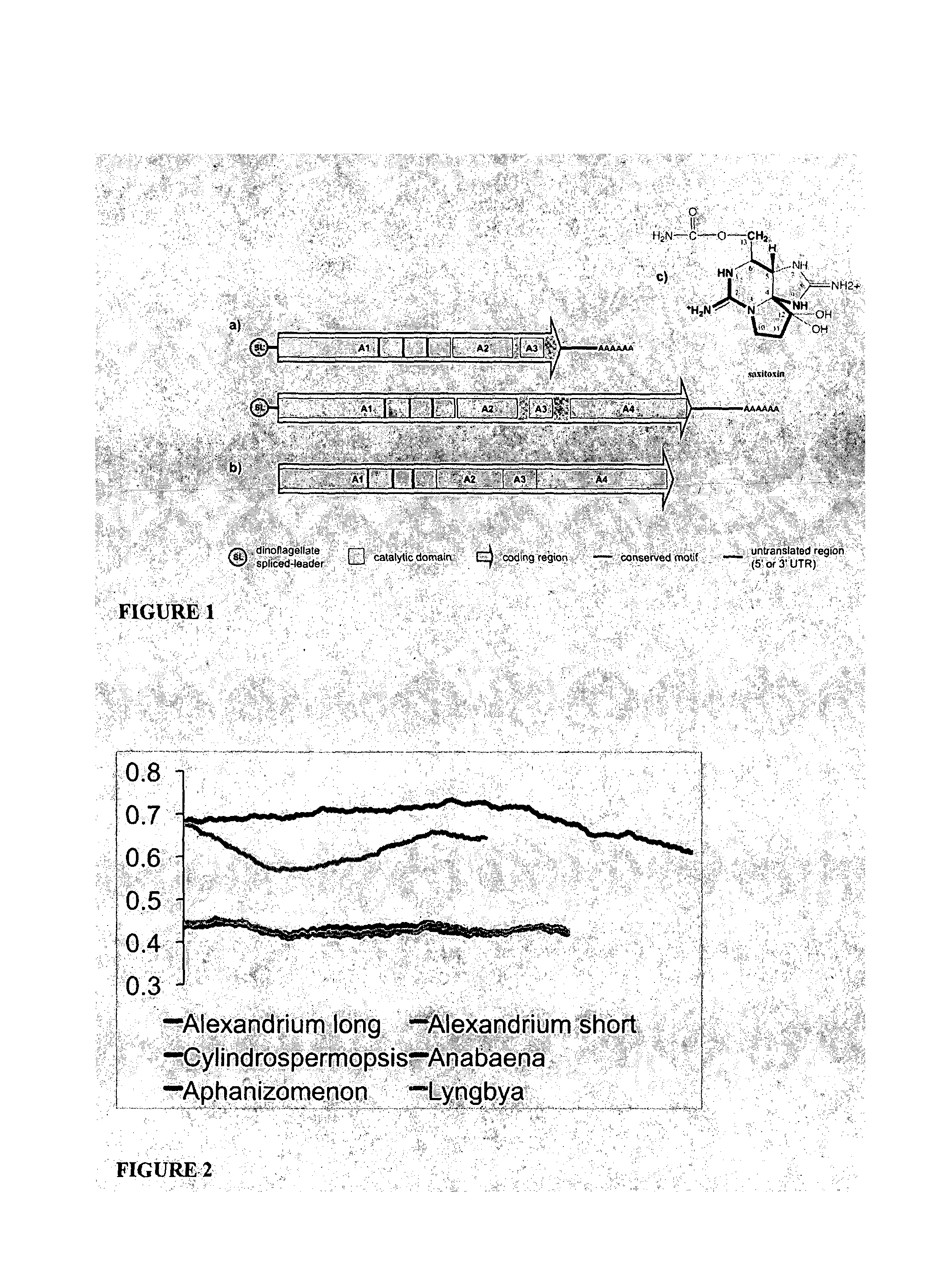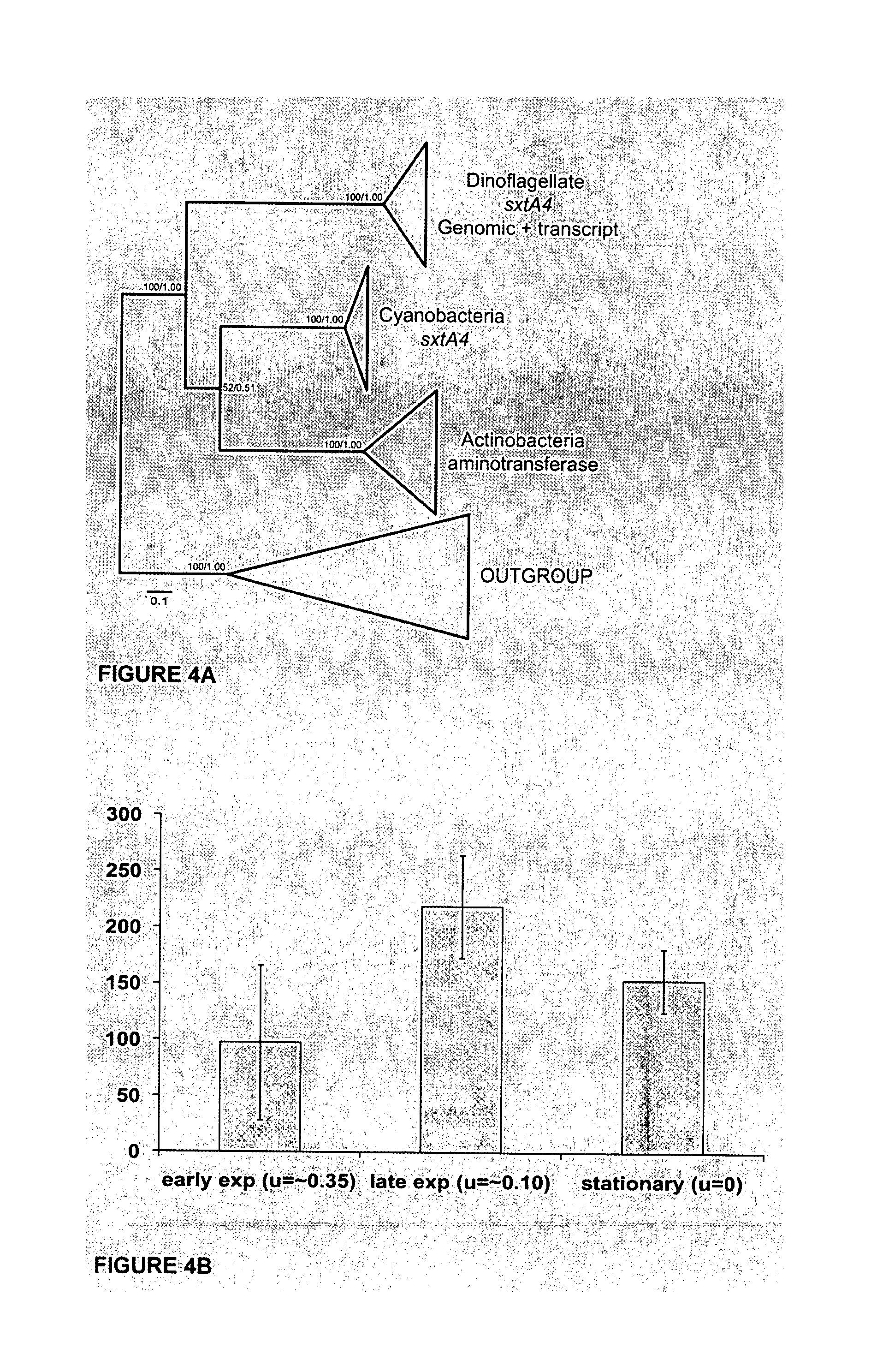Detection of saxitoxin-producing dinoflagellates
a dinoflagellate and saxitoxin technology, applied in the field of saxitoxins and the identification of microorganisms, can solve the problems of paralysis and death, annual economic loss from harmful plankton blooms, and poisoning of paralytic shellfish
- Summary
- Abstract
- Description
- Claims
- Application Information
AI Technical Summary
Benefits of technology
Problems solved by technology
Method used
Image
Examples
example 1
Identification of Nuclear-Encoded Genes for the Neurotoxin Saxitoxin in Dinoflagellates
Materials and Methods
[0188]Culturing and Toxin Measurements
[0189]Saxitoxin-producing and non-producing dinoflagellate cultures were obtained from various culture collections (Table 1).
TABLE 1List of dinoflagellate strains used in this study, their production of STX andwhether sxtA1 and sxtA4 fragments were amplified from their genomic DNA.PCRPCROrderGenusSpeciesStrainSTXsxtA1sxtA4GonyaulacalesaffineCCMP112n.d.n.d.n.d.affineAABB01 / 01n.d.n.d.n.d.affineAABB01 / 02n.d.n.d.n.d.andersoniiCCMP1597n.d.n.d.n.d.andersoniiCCMP2222n.d.n.d.n.d.catenellaACCC01yesyesyescatenellaACSH02yesyesyescatenellaACTRA02yesyesyescatenellaCCMP1493yesyesyesfundyenseCCMP1719yesyesyesfundyenseCCMP1979yesyesyesminutumCCMP1888yesyesyesminutumCCMP113yesyesyesminutumALSP01yesyesyesminutumALSP02yesyesyesminutumAMD16yesyesyestamarenseCCMP1771n.d.yesyestamarenseATBB01n.d.yesyestamarenseATEB01n.d.yesyestamarenseATCJ33n.d.yesyestamarenseA...
example 2
Quantitative Method for Detecting and Quantifying STX Production in Dinoflagellates
Materials and Methods
[0248]Culture Maintenance
[0249]Dinoflagellate cultures (Table 4) were maintained in GSe (Doblin et al., 1999, supra) or L1 media (Guillard & Hargraves, 1993 supra) at 16-20° C. Light was provided by white fluorescent bulbs (Crompton Light), with photon flux of 60-100 μmol photon m−2 sec−1 on 12 / 12 hour dark / light cycle. Strains used were provided by the University of Tasmania (isolated by M. de Salas) the Australian National Culture Collection of Marine Microalgae, Provasoli-Guillard Culture Collection (CCMP) and the Cawthron Institute Culture Collection.
TABLE 4Dinoflagellate strains tested, STXs content and whether the sxtA4qPCR primer pair resulted in a product. All samples were tested witha positive control to ensure PCR inhibitors were not present.sxtA4StrainSTXsqPCRDinoflagellatenumberdetected1productaffineCCMP112−−affineCS-312 / 02−−andersoniiCCMP1597−−andersoniiCCMP2222−−cate...
example 3
Investigation of sxtA Sequences in Saxitoxin Producing and Non-Producing Dinoflagellate Species
Aim
[0289]To amplify and sequence genes involved in the synthesis of saxitoxin (STX) in dinoflagellates which are known to produce saxitoxin and those which are not known to produce STX.
Materials and Methods
[0290]Dinoflagellate strains were grown in GSe media and maintained in a culture cabinet at 18 degrees, and a 12 / 12 light cycle. DNA was extracted from 20 ml of exponentially growing culture by harvesting by centrifuging at 3000 g for 5 minutes, then using the CTAB method.
[0291]DNA template was PCR amplified using Advantage GC rich PCR polymerase (Clontech), which contains 10% BSA, in a Thermo Cycler with the following PCR conditions: an initial 5 minute 95° C. denaturing before 35 cycles of (1) 30 sec 94° C. denaturing, (2) 30 sec annealing (variable temperature), and (3) 1-2 minute 72° C. extension, with a final 10 minute extension at the same temperature. PCR products were gel excised...
PUM
| Property | Measurement | Unit |
|---|---|---|
| volumes | aaaaa | aaaaa |
| volume | aaaaa | aaaaa |
| volume | aaaaa | aaaaa |
Abstract
Description
Claims
Application Information
 Login to View More
Login to View More - R&D
- Intellectual Property
- Life Sciences
- Materials
- Tech Scout
- Unparalleled Data Quality
- Higher Quality Content
- 60% Fewer Hallucinations
Browse by: Latest US Patents, China's latest patents, Technical Efficacy Thesaurus, Application Domain, Technology Topic, Popular Technical Reports.
© 2025 PatSnap. All rights reserved.Legal|Privacy policy|Modern Slavery Act Transparency Statement|Sitemap|About US| Contact US: help@patsnap.com



